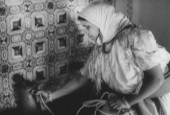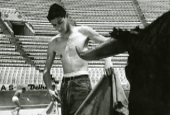 Moroccan Romance, 1939. Filmed during the Spanish Civil War, Carlos Velo and Enrique Domínguez Rodiño’s Moroccan Romance (Romancero marroquí) bears the imprint of Robert Flaherty’s ethnographic documentaries in its distilled (if manipulated) images of a distant, exotic – and exoticized – culture. Part colonialist travelogue on aspects of life in contemporary Morocco (and implicitly, the benefits of imposed western culture on the native population in such areas as medicine and the local economy) and part recruitment propaganda extolling the virtues of a franquista revolution, the film reflects what author Marsha Kinder describes as the idiosyncrasies of Spanish documentary in its malleable fusion of real and constructed history. Composed of seemingly disparate segments – a panorama of Morrocan customs, a human interest story on a Moroccan farmer, Aalima, who volunteers to serve in Franco’s army, a youth march in Spain – the film’s fractured construction invariably reflects its complicated production history, specifically, Carlos Velo’s precarious role as a leftist republican covertly working on a commissioned project that promotes a nationalist agenda. Forced to flee the protectorate before the editing of the film to avoid exposure (Velo would eventually live in exile in Mexico), Velo nevertheless asserts his unmistakable aesthetic in the spare compositions and textured landscapes that capture the quotidian, even as jingoistic sermons on colonialist unity, romanticized images of war, and a sobering epilogue depicting youth military exercises that trivialize warfare as a series of role-playing exercises undercut the film’s essential, humanist tone.
Moroccan Romance, 1939. Filmed during the Spanish Civil War, Carlos Velo and Enrique Domínguez Rodiño’s Moroccan Romance (Romancero marroquí) bears the imprint of Robert Flaherty’s ethnographic documentaries in its distilled (if manipulated) images of a distant, exotic – and exoticized – culture. Part colonialist travelogue on aspects of life in contemporary Morocco (and implicitly, the benefits of imposed western culture on the native population in such areas as medicine and the local economy) and part recruitment propaganda extolling the virtues of a franquista revolution, the film reflects what author Marsha Kinder describes as the idiosyncrasies of Spanish documentary in its malleable fusion of real and constructed history. Composed of seemingly disparate segments – a panorama of Morrocan customs, a human interest story on a Moroccan farmer, Aalima, who volunteers to serve in Franco’s army, a youth march in Spain – the film’s fractured construction invariably reflects its complicated production history, specifically, Carlos Velo’s precarious role as a leftist republican covertly working on a commissioned project that promotes a nationalist agenda. Forced to flee the protectorate before the editing of the film to avoid exposure (Velo would eventually live in exile in Mexico), Velo nevertheless asserts his unmistakable aesthetic in the spare compositions and textured landscapes that capture the quotidian, even as jingoistic sermons on colonialist unity, romanticized images of war, and a sobering epilogue depicting youth military exercises that trivialize warfare as a series of role-playing exercises undercut the film’s essential, humanist tone.
Almadrabas, 1934. Carlos Velo and Fernando G. Mantilla’s quietly observed documentary, Almadrabas loosely prefigures Agnès Varda’s La Pointe courte in capturing the rhythm and rituals of a small fishing village. Ostensibly titled after the Moorish word describing the structure of nets, the film follows the product cycle of canned tuna – from the fishermen who go out to sea to trawl the ocean, to the fishmongers who clean and dress the fish for curing and sale, to the cannery workers who cook, season, and package them in tins for export. As the title suggests, Almadrabas also illustrates the interconnectedness of the village, both as a close knit community and as workers contributing to the town’s primary industry. In a way, Velo and Mantilla’s idiosyncratic use of amplified ambient sounds, most notably in the cadence of water droplets and the undifferentiated white noise of machinery, anticipates Ritwik Ghatak’s use of allusive sounds as a reflection of internal states. However, rather than imposing a psychological framework, Velo and Mantilla allude to an integrally sociopolitical context in their juxtaposition of village life and commerce, figuratively aligning the circumstances of the villagers with those of the hapless fish captured in their highly efficient nets, destined to feed the insatiable appetites of an anonymous, consumer-driven global economy.
 Torero, 1956. Refining the theme of documented reality and reconstructed history introduced in his earlier film, Moroccan Romance, Carlos Velo’s reflective and ecstatic Torero is equally an autobiography on charismatic Mexican bullfighter, Luis Procuna, and an unvarnished examination of bullfighting culture. Presented as an extended interior monologue as an anxious Procuna prepares to return to the ring after a prolonged absence caused by injury, as well as the unexpected death of cerebral, renowned Spanish bullfighter and admired contemporary, Manolete, the film seamlessly interweaves past and present, archival footage and re-enactment. Chronicling Procuna’s rise from abject poverty (underscoring the correlation between bullfighting and escapism that also runs through Llorenç Soler’s 52 Sundays), makeshift training, inauspicious debut, and personal and professional milestones, Velo incisively captures the ambivalent, often contradictory nature of the collective spectacle, where the relationship between the bullfighter and the audience proves to be as fickle and mercurial as the bulls themselves. Velo illustrates this ephemerality through two near real-time sequences that figuratively bookend Procuna’s career – first, as a third-billed performer who emerges from the shadows after injuries cut short the main attraction, then subsequently, as a famous bullfighter nearing the end of his career who is goaded into returning to the ring, only to be jeered when his performance proves to be cautious. Juxtaposed against images of Procuna’s humble aspirations – his childhood home, his mother’s memorial, his loving family – Velo presents as thoughtful allegory for the fragile, often arbitrary delineation between humanity and mythology, where transcendence, like truth, lies in the inconstant eye of the beholder.
Torero, 1956. Refining the theme of documented reality and reconstructed history introduced in his earlier film, Moroccan Romance, Carlos Velo’s reflective and ecstatic Torero is equally an autobiography on charismatic Mexican bullfighter, Luis Procuna, and an unvarnished examination of bullfighting culture. Presented as an extended interior monologue as an anxious Procuna prepares to return to the ring after a prolonged absence caused by injury, as well as the unexpected death of cerebral, renowned Spanish bullfighter and admired contemporary, Manolete, the film seamlessly interweaves past and present, archival footage and re-enactment. Chronicling Procuna’s rise from abject poverty (underscoring the correlation between bullfighting and escapism that also runs through Llorenç Soler’s 52 Sundays), makeshift training, inauspicious debut, and personal and professional milestones, Velo incisively captures the ambivalent, often contradictory nature of the collective spectacle, where the relationship between the bullfighter and the audience proves to be as fickle and mercurial as the bulls themselves. Velo illustrates this ephemerality through two near real-time sequences that figuratively bookend Procuna’s career – first, as a third-billed performer who emerges from the shadows after injuries cut short the main attraction, then subsequently, as a famous bullfighter nearing the end of his career who is goaded into returning to the ring, only to be jeered when his performance proves to be cautious. Juxtaposed against images of Procuna’s humble aspirations – his childhood home, his mother’s memorial, his loving family – Velo presents as thoughtful allegory for the fragile, often arbitrary delineation between humanity and mythology, where transcendence, like truth, lies in the inconstant eye of the beholder.
Acquarello, 2009 [reprinted]